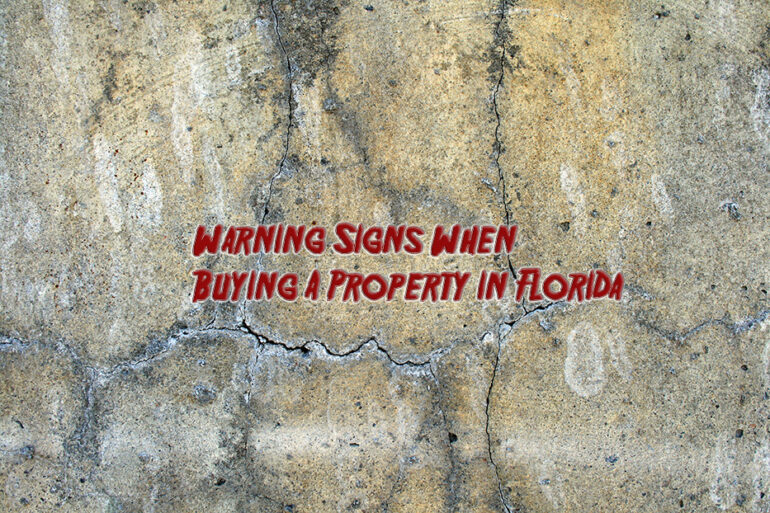Warning Signs When Buying A Property in Florida
Warning Signs When Buying a Property in Florida
In all U.S. states, there are warning signs to look for when buying a property, whether you are planning to live in the property or are purchasing it as an investment.
I want to take you through some of the biggest warning signs for Florida properties, especially those that are particular to certain parts of the state.
Avoid Sinkholes at All Costs
Sinkholes are generally in the central to northwest area of Florida. A sinkhole, according to the Florida Department of Environmental Protection, is a depression in the ground that has no external surface drainage. That means when it rains (and Florida is known for its thunderstorms and hurricanes), all of the water stays inside the sinkhole and typically drains into the subsurface.
Sinkholes are very common in “karst terrain,” where the types of rock below the surface of the land can naturally be dissolved by groundwater circulating through them. These soluble rocks include salt beds and domes, limestone, gypsum, and other carbonate rock.
Florida is highly susceptible to sinkholes as it is largely underlain by limestone. Sinkholes can be dramatic as the land usually stays intact for a length of time until the underground spaces just get too big. If there is not enough support for the land, then there can be a sudden collapse of the land surface.
Patrick Rossi of GreatFlorida Insurance indicated that if a proper sinkhole has happened within a few miles of the insured’s property or if there is a crack in the driveway, wall, foundation, or patio, then coverage may be denied.
Check for Foundation Issues
Another common warning sign when buying a property in Florida is foundation problems caused by poor soil conditions and the fact that most homes and multi-story buildings in Florida are constructed on a concrete slab. This is due to the groundwater table, which is water that sits underground. Issues include foundation settlement, shifting foundation, sinking foundation, and foundation cracks.
If a new structure is built during extreme weather conditions or on improper soil, then the new house can be subject to substantial settlement within the first five years. This usually occurs when the new house is contracted during a drought and then heavy rainfall happens after the structure is built.
The clay soil will expand, and the structure built on a slab will experience some settlement. If a drought then occurs shortly after, the clay will retract, causing several inches of settlement within just a few weeks or months.
A cracked foundation can lead to a multitude of problems within a structure. It is important to be aware of and searching for signs of foundation failure. Your foundation is the support system for your entire home, and it is critical that it is repaired early in the game.
Florida’s limestone base creates an unsteady surface that can change with moisture and water conditions. You may
not see a crack in your actual foundation structure, but you may notice warning signs inside your home.
You may see cracks on the wall, separation may appear between your floor and wall, and windows may not align and become hard to open or close. You must act quickly — the longer you ignore it, the bigger the problem becomes.
Consider Severe Weather Conditions
Florida hurricanes — where do we begin! According to the National Oceanic and Atmospheric Administration, Hurricane Irma, which began on August 30, 2017, caused 6.3 million people to be evacuated from Florida (the largest evacuation in U.S. history).
65% of houses in the Florida Keys were damaged and 25% were destroyed, 15 million people in Florida went without power, and 70,000 square miles were impacted by the hurricane or tropical storm force winds. Those are just the stats for one hurricane!
The most common type of hurricane damage is from high-speed projectiles, such as uprooted trees, outdoor furniture, cars, and debris, that can break through your home’s glass doors and windows. Storm surges, which are the deadliest result of a hurricane, can cause sea levels to rapidly rise as the hurricane makes landfall. These surges can devastate an area and engulf any object in its path.
Obviously, flooding damage is when prolonged rainfall accompanies hurricanes with significant flooding up to 50 inches (recorded for Irma and Harvey). Spin-off tornadoes can be created when hurricane winds speed up. This also can uproot trees and homes, which creates more windborne debris.
It would be impossible to eliminate every type of potential damage caused by hurricanes, but there are ways to reduce the extent of damage, such as installing impact glass windows and doors to create a tighter seal on your home. These will reduce water infiltration and keep windborne debris from breaking through and wreaking havoc.
Because of Florida’s hurricane and violent storm history, roof issues are heavily scrutinized when it comes to eligibility for property insurance, according to Patrick Rossi.
“Usually, shingle roofs are good for up to 10 years and tile and metal roofs for up to 20 years. Insurance underwriters will look at photos from the wind mitigation and four-point inspections at the time of binding a policy and will check photos or drone footage once the carried orders their own physical inspection of the property. If any tiles are missing or the roof has cracked, or the roof is very faded or bowing in a certain area, there will probably be a cancellation notice generated unless the homeowner replaces the roof. Typically this only happens if the area of concern is large enough where a simple repair will not suffice,” he states.
Florida’s weather conditions are famous for causing roof problems, especially during the summer months when Florida’s storms, humid climate, flooding, hurricanes, and high temperatures cause the above problems. Following a tropical storm or hurricane, blow-off damage can remove the finished roofing from a section of your roof. In extreme cases, roofing felt and sheathing can also be blown off.
Damaged gutters, flashing, and downspouts can come with extreme weather. The flashing is designed to keep water from building materials and structures which are damaged by excess water. Downspouts and gutters prevent flooding and moisture damage, so any of these components, if damaged, should be repaired immediately.
Finally, skylights are commonly damaged in storms from windblown debris, which can crack the skylight wide open, so oftentimes a new skylight is required.
Inspect Plumbing
Cast iron and polybutylene pipes are not acceptable for insurance underwriters for your plumbing requirements. Polybutylene can be a very fragile material that breaks, causing water damage.
Cast iron pipes, mainly seen in the southeast area of Florida in homes built during the 1950s to 1970s, is an issue due to the age of the pipes. They rust over time, and grains entering the pipes can eventually cause pinhole leaks. So, check all your plumbing requirements before constructing a new home or purchasing one for flipping or living in.
Be sure to check that you are covered in all situations when possible, including any issues specific to Florida, so that you and your property are not at any financial risk.








